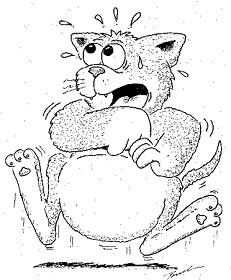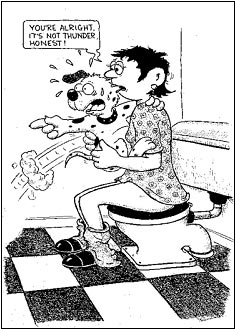What
is fear?
Fear
is a physiologic, behavioral
and emotional reaction to stimuli
that an animal encounters. The
physiologic reaction results
in an increase in heart rate,
increased respiratory rate (panting),
sweating, trembling, pacing
and possibly urination and defecation.
Behaviorally an animal will
exhibit changes in body posture
and activity when afraid. The
animal may engage in an avoidance
response such as fleeing or
hiding. A fearful animal may
assume body postures that are
protective such as lowering
of the body and head, placing
the ears closer to the head,
widened eyes, and tail tucked
under the body. If the animal
perceives a threat, the response
can also include elements of
defensive aggression. Whether
an animal fights or flees when
fearful or defensive depends
on its genetic predisposition
and the environment that it
is in (see below). The emotional
reaction in animals can be difficult
to gauge because animals are
non-verbal. However, by observation
of body postures and facial
expressions it is possible to
conclude that an animal is afraid.
Is
fear ever an abnormal response
in animals?
In
many situations it is "acceptable
and understandable" for
an animal to be afraid. However,
there are times when animals
exhibit fear when it is maladaptive
or dangerous for humans. When
animals are frightened they
may become aggressive (fight),
run away (flight), or stay still
(freeze). The response a pet
exhibits depends on the pet's
personality, the type of stimulus,
previous experience with the
stimulus, whether it is on its
own property (where it is more
likely to fight), whether it
is in the presence of offspring
or family members (where it
is more likely to fight), or
whether it is cornered or restrained
and unable to escape (where
it is more likely to fight).
What
is a phobia?
This
is an intense response to a
situation that the animal perceives
as fear inducing. The response
is out of proportion to the
stimulus and is maladaptive.
Common phobias in animals involve
noises and places. Phobic responses
have physiologic, behavioral
and emotional responses similar
to fear, but they are extremely
exaggerated.
What
is anxiety?
The
human definition of anxiety
is a diffuse feeling of impending
danger or threat. It appears
that animals can exhibit this
diffuse type of anxiety, often
manifested as generalized anxious
behavior in either specific
situations (the veterinary hospital,
new locations) or in a non-specific
way (anything out of the routine
schedule or environment). Anxiety
is manifested by some of the
same physiologic signs as fear,
but also may be displayed as
displacement or redirected behaviors,
destructive behaviors, or excessive
vocalization, and may become
stereotypic or compulsive over
time.
What
types of stimuli might trigger
fears, phobias or anxieties?
The
triggers for these behaviors
are as varied as there are breeds
of dogs and cats. Animals may
be frightened of people, other
animals, places or things. Others
may only respond with fear or
phobia in one particular situation
such as toward a thunderstorm.
 What
causes fearful, phobic or anxious
responses? What
causes fearful, phobic or anxious
responses?
Sometimes
fear is the result of an early
experience that was unpleasant
or perceived by the animal as
unpleasant. If the fearful response
was successful at chasing away
the stimulus, or if the pet
escaped from the stimulus, the
behavior has been rewarded.
Owners that try to calm their
pet by providing treats or affection
may be rewarding the fearful
behavior. Also, it should be
noted that punishment, in close
association with exposure to
a stimulus might further cause
fear and anxiety toward that
stimulus.
It
does not take an unpleasant
experience however for fear
to develop. Any stimuli (people,
places, sights, sounds, etc.)
that a dog or cat has not been
exposed to during its sensitive
period of development, which
is up to 3 months in dogs and
2 months in cats, may become
a fear evoking stimulus. For
example, the dog or cat that
is exposed to adults, but not
children during development
may become fearful when first
exposed to the sights, sounds
or odors of young children.
The pet's genetics also
contributes to its level of
fears and phobias to stimuli.
Phobic
responses can occur from just
one exposure or gradually increase
over continued exposure. In
many cases of anxiety, neurotransmitter
(brain chemical) function and
levels may be altered and contribute
to the overall behavior. Again,
learning or the consequences
that follow the phobic response
(rewards, escape, punishment)
may aggravate the problem.
Illness,
pain and the effects of aging
may lead to an increase in fear
or anxiety in situations where
there was previously little
or no evidence. These changes
may change the way a pet perceives
or responds to a stimulus. Age
related changes in the brain
(cognitive decline) or in the
sensory system (hearing, sight),
arthritis, diseases that affect
the hormonal system such as
an increase or decrease in thyroid
hormones or an overactive pituitary
gland (Cushing's) and
organ decline (liver, kidneys)
are just a few examples of health
and age related problems that
might contribute to increasing
fear and anxiety.
Is
it possible to prevent fears,
phobias and anxieties?
A
good program of socialization
and exposure to many new and
novel things while an animal
is young can be helpful in preventing
fears and phobias. However,
in the phenomena of "one
trial" learning, an event
is so traumatic that only one
exposure can create fears, phobias
or anxieties.
Owner
responses when their pet experiences
a new situation that could potentially
be frightening are important.
Calm reassurances as long as
the pet is not acting fearful,
happy cheerful tones, and relaxed
body postures of owners help
pets experience new things without
fear. Bringing along treats
and play toys and giving them
to the pet when it enters new
environments (e.g. veterinary
clinic, schoolyard) or when
it meets new people or other
pets can help turn the situation
into one that is positive. Conversely,
anxiety or apprehension on the
part of the owners or fear evoking
training techniques such as
punishment may serve to increase
the pets' fear and anxiety.
Knowing your pet and their individual
temperament will also determine
what situations you can and
should expose your pet to.
How
can these problems of fears
and phobias be treated?
Each
time your pet is exposed to
an anxiety, fear, or phobia-inducing
situation and cannot be made
to calm down, the problem is
likely to worsen. Finding a
way to control, relax, calm,
or distract your pet in the
presence of the stimulus is
needed to correct the problem
and to teach your pet that there
is nothing to be feared. An
owner who is calm and in control
reduces the fear and anxiety
associated with new stimuli
and situations. For most cases
of fear, behavior modification
techniques, where the pet is
exposed to mild levels of the
stimuli and rewarded for non-fearful
behavior, are utilized. For
low levels of fear or anxiety,
especially when the pet is being
exposed to new stimuli, many
pets will calm down with continued
exposure, as long as nothing
is done to aggravate the fear.
These retraining techniques
are discussed in our handout
on Behavior modification –
reducing fear and anxiety –
desensitization, counter-conditioning
and flooding. Consequences that
reinforce the fear (inadvertent
rewards or retreat of the stimulus)
or aggravate the fear (punishment)
must be identified and removed.
Drug therapy may also be a useful
adjunct to behavior therapy
techniques and may be necessary
in the treatment of some phobias.

This client
information sheet is based on
material written by Debra Horwitz,
DVM, DACVB and
Gary Landsberg, DVM, DACVB.
© Copyright 2002 Lifelearn
Inc. Used with permission under
license. March 11, 2004.
|